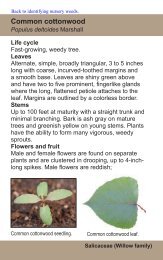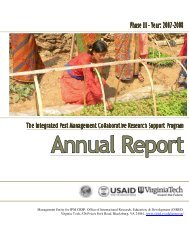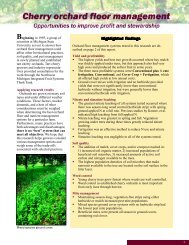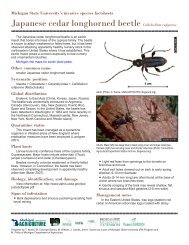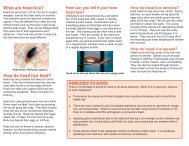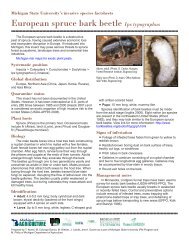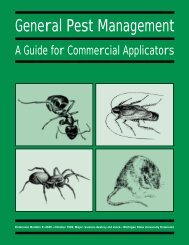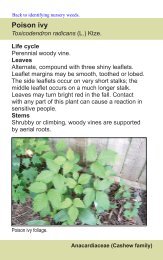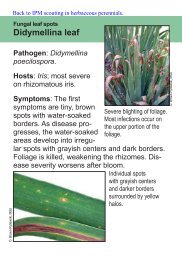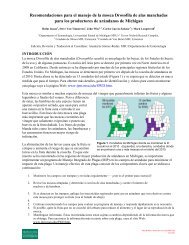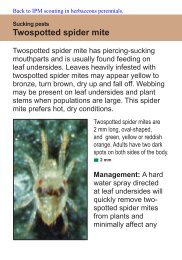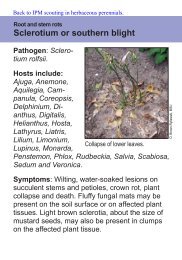Whole Manual - Michigan State University: Integrated Pest ...
Whole Manual - Michigan State University: Integrated Pest ...
Whole Manual - Michigan State University: Integrated Pest ...
You also want an ePaper? Increase the reach of your titles
YUMPU automatically turns print PDFs into web optimized ePapers that Google loves.
hawk moths. Single light green eggs are laid on the<br />
undersides of leaves. When eggs hatch, larvae feed on<br />
leaves and fruit before pupating in the soil. In <strong>Michigan</strong>,<br />
there may be two to three generations a year.<br />
Tomato hornworm larva (top) and adult (bottom).<br />
Damage: With their chewing mouthparts, these large<br />
caterpillars eat leaves of tomatoes, eggplants, and peppers<br />
and can also bore into tomato fruit. Tomato hornworm<br />
damage can cause 100 percent of the product to be<br />
unmarketable.<br />
Control strategies:<br />
■ Small infestations of tomato hornworms can be hand<br />
picked from plants. Look closely when scouting<br />
plants for tomato hornworms -- they are well camouflaged<br />
and difficult to see until they are large enough<br />
to defoliate plants.<br />
■ A number of natural enemies help control tomato<br />
hornworms. For example, caterpillars parasitized by a<br />
tiny wasp will have tiny, white wasp cocoons on them.<br />
Parasitized larvae do not develop into adult hornworms,<br />
but they do continue to feed.<br />
■ Many foliar insecticides control tomato hornworms.<br />
TOMATO FRUITWORM (Heliocoverpa zea)<br />
The tomato fruitworm is also known as the corn earworm.<br />
The adult moth migrates into <strong>Michigan</strong> each year<br />
beginning in late June. Moths are active at night, and<br />
female moths are attracted to flowering and fruiting<br />
tomato plants. Small, yellow eggs are laid near or on the<br />
tomato. Newly hatched larvae vary in color from pink<br />
and green to maroon, brown, and tan and begin at once<br />
to feed on the tomato. A fully mature larva can grow to<br />
1 3/4 inches long. Mature caterpillars drop from the plant<br />
and pupate in the soil. There are two to three generations<br />
per year in <strong>Michigan</strong>.<br />
Damage: Tomato fruitworm caterpillars attack green<br />
tomatoes. They bore into the fruit, creating a deep,<br />
watery cavity. The cavity creates an entry point for secondary<br />
fungal infections. Damaged fruit is unmarketable<br />
and usually falls from the vine.<br />
Control strategies:<br />
■ Naturally occurring biological control agents such as<br />
parasitic wasps and flies are very important in the<br />
control of tomato fruitworm.<br />
■ Tomato fruitworm adults can be monitored using<br />
pheromone lures and traps placed near tomato plants<br />
or cornfields. Scout fields to monitor fruit feeding. It is<br />
important to treat when the larvae are small, because<br />
once they enter the fruit, insecticide applications will<br />
not be effective.<br />
GENERAL VEGETABLE INSECT PESTS<br />
SEEDCORN MAGGOT (Delia platura)<br />
Seedcorn maggots have a wide host range including<br />
corn, snap beans, and cucurbits. They overwinter in the<br />
soil as small, brown pupae. Beginning in early April,<br />
adult seedcorn maggots emerge. The adult is a small,<br />
gray fly, similar to a housefly. Female flies deposit eggs in<br />
the soil and are attracted to soil high in organic matter,<br />
either plowed-down crop residue or animal manure.<br />
Larvae or maggots feed on decomposing plant material<br />
and seeds. Seedcorn maggots favor cold, wet weather.<br />
There are multiple generations a year, but only the first<br />
generation is of economic concern.<br />
Damage: Larvae feed on decomposing plant matter and<br />
seeds. Seeds can be attacked before or after germination.<br />
Damaged seeds may not sprout or produce malformed,<br />
stunted plants. Attacked seedlings will wilt and die within<br />
a few days.<br />
Control strategies:<br />
■ If planting into a field that has a cover crop, plow<br />
down the cover crop three to four weeks before planting.<br />
This provides enough time for decomposition.<br />
■ Insecticide seed treatments are an effective way to<br />
control seedcorn maggot.<br />
Vegetable Crop <strong>Pest</strong> Management 47<br />
Chapter 5



